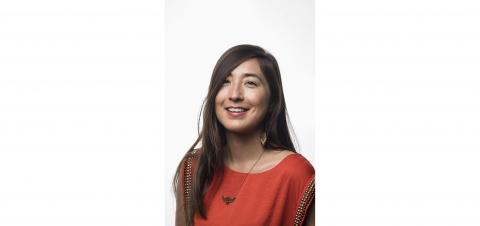
Miho Janvier : Exploring solar storms
Miho Janvier is a researcher in astrophysics at the Institut d’Astrophysique Spatiale (IAS - Université Paris-Saclay, CNRS). She specialises in the physics of the Sun and the interplanetary medium, and is actively involved in the adventure of the Solar Orbiter probe, which was launched into orbit on 10 February 2020 to explore the heliosphere.
“Solar storm chaser”, a title worthy of an adventure film for an avid and dedicated researcher. Astrophysicist Miho Janvier is always ready to share her knowledge, as she seeks to understand and unveil the secrets surrounding the phenomenon of solar winds.
Unravelling the secrets of solar plasma
Miho Janvier's scientific adventure began during her engineering studies in power and nuclear engineering. She specialised in particle physics and took the Japanese equivalent of a 2-year master's degree, in the field of plasma physics.
“What really fascinated me in plasma physics was the interaction between atomic physics and the physics governing electromagnetic fields. This same physics describes the stars, and we even believe that 99% of the visible matter in the universe is composed of plasma”, the researcher continued enthusiastically.
After writing a thesis in this field, she was awarded a research contract to work on the physics of the Sun. She obtained a permanent position at the French National Council of Astronomers and Physicists (CNAP) to study the physics of the sun and the interplanetary medium, and in particular the influence of the star on the solar system.
“The Sun is the closest star to us. It is a fascinating laboratory, rich with data, contrary to other stars, which are too far away from us. This data allows us to test our theoretical predictions on plasma physics in the natural environment of space", explained Miho Janvier.
Her work at CNAP is divided into three categories: research, teaching and in the observation department. This third category involves documenting the long-term formation, development and variability of star systems and terrestrial environments, and to further knowledge in these fields. With this spirit of serving the scientific community in mind, she joined the Solar Orbiter project.
At the end of the day, Miho Janvier divides her time between the classes she teaches at Université Paris-Saclay, her research and the observation meetings on the Solar Orbiter mission, during which she and her colleagues plan which observations are to be made all along the space probe’s seven-year journey. She is also involved in the important work of analysing the data obtained by space projects, a lengthy task but still a necessary one in order to be able to provide knowledge to experts and scientific communities.
The Solar Orbiter mission, bringing news from the heliosphere
Solar Orbiter is a space probe that was launched into space in early 2020 by the European Space Agency (ESA) and NASA. Its mission is to study the heliosphere, the 'bubble’ surrounding the Sun where the solar winds roar. The aim is to learn more about our own star and about solar winds. As a specialist in the field, Miho Janvier takes a special interest in coronal mass ejections (CME). These are fragments of matter or “ejecta”, solar plasma and magnetic fields from the Sun's atmosphere. These events form a sort of huge cloud coming out of the Sun that travels through the solar system.
“I like to call them space hurricanes. Depending on their trajectory, they can reach planets in the solar system, including the Earth, and cause things like the aurora borealis, as well as affecting our satellites and our electric circuits. Human technology is directly affected by these events”, the researcher explained.
However, although we have images of these events when they arise - when they are ejected -, there are no such image of when the hurricanes dilute on their way through the solar system, despite the fact that they continue to affect their surroundings.
"To understand what is going on in the Sun's atmosphere, we need images. Solar Orbiter has six remote detection instruments and telescopes on board for this purpose. To follow the progress of CMEs ejected into the interplanetary medium, Solar Orbiter has four instruments in situ. These instruments are sensors that will explore the whole environment around the probe and collect an ensemble of data, calculating or measuring the temperature, the magnetic field, etc.”, the researcher summed up.
The Solar Orbiter has ten instruments but one of them, the SPICE spectrometer, is specifically placed under the authority of IAS: the team to which Miho Janvier belongs will be handling its operations. Its work is to select zones of the Sun and the types of phenomenon to be studied, the right time to do it, etc. This data is eagerly awaited by researchers around the world to be able to continue their analysis.
Scientific knowledge for the common good
Miho Janvier has a strong taste for passing down knowledge and training future generations of researcher: teaching forms an important part of her daily routine. In partnership with specialists in new technologies, she is also developing augmented virtual reality applications in astrophysics and on the Solar Orbiter mission.
“Scientific mediation is a way of connecting to young people, to our families and to the general public overall, and, in my view, that is one of our responsibilities as researchers. We are paid from public funds, so it is important to share science and our knowledge with the whole social body. Communication campaigns can also show the diversity of scientific professions and the presence of young people and women, and that in the end, there are as many profiles as there are researchers”, Miho Janvier concluded.
There is no doubt in Miho Janvier’s mind: science is a vocation and a passion. She is one of the 9,000 teacher-researchers and researchers at Université Paris-Saclay who every day extend the frontiers of knowledge and make knowledge-sharing a real issue for society.
